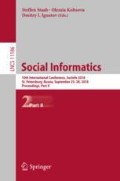Abstract
Human evacuation experiments can trigger distress, be unethical and present high costs. As a solution, computer simulations can predict the effectiveness of new emergency management procedures. This paper applies multi-agent simulation to measure the influence of staff members with diverse training levels on evacuation time. A previously developed and validated model was extended with explicit mechanisms to simulate staff members helping people to egress. The majority of parameter settings have been based on empirical data acquired in earlier studies. Therefore, simulation results are expected to be realistic. Results show that staff are more effective in complex environments, especially when trained. Not only specialised security professionals but, especially, regular workers of shopping facilities and offices play a significant role in evacuation processes when adequately trained. These results can inform policy makers and crowd managers on new emergency management procedures.
Access this chapter
Tax calculation will be finalised at checkout
Purchases are for personal use only
Notes
- 1.
- 2.
- 3.
- 4.
Source code available to download in: (https://formolo.wixsite.com/impact-project).
- 5.
References
Canter, D.V.: Fires and Human Behaviour. Wiley, New York (1980)
Proulx, G.: How to initiate evacuation movement in public buildings. Facilities 17, 331–335 (1999)
Samochine, D., Boyce, K., Shields, T.: An investigation into staff behaviour in unannounced evacuations of retail stores - implications for training and fire safety engineering. Fire Saf. Sci. 8, 519–530 (2005). https://doi.org/10.3801/IAFSS.FSS.8-519
Shields, T., Boyce, K.: A study of evacuation from large retail stores. Fire Saf. J. 35, 25–49 (2000). https://doi.org/10.1016/S0379-7112(00)00013-8
Gwynne, S.M.V., Purser, D., Boswell, D.L.: Pre-warning staff delay: a forgotten component in ASET/RSET calculations. In: Peacock, R.D., Kuligowski, E.D., Averill, J. (eds.) Pedestrian and Evacuation Dynamics, pp. 243–253. Springer, Boston (2011). https://doi.org/10.1007/978-1-4419-9725-8_22
Smith, C.A., Ellsworth, P.C.: Patterns of cognitive appraisal in emotion. J. Pers. Soc. Psychol. 48, 813 (1985)
de Vries, P.W., Galetzka, M., Gutteling, J.M.: Inzet communicatie bij crowd management en crowd control. Universiteit Twente-Faculteit Gedragswetenschappen (2013)
Bosse, T., Hoogendoorn, M., Klein, M.C.A., Treur, J., van der Wal, C.N., van Wissen, A.: Modelling collective decision making in groups and crowds: integrating social contagion and interacting emotions, beliefs and intentions. Auton. Agent. Multi-Agent Syst. 27, 52–84 (2013). https://doi.org/10.1007/s10458-012-9201-1
Tsai, J., et al.: ESCAPES—Evacuation Simulation with Children, Authorities, Parents, Emotions, and Social comparison, p. 8 (2011)
Pelechano, N., O’Brien, K., Silverman, B., Badler, N.: Crowd simulation incorporating agent psychological models, roles and communication. In: First International Workshop on Crowd Simulation, pp. 21–30 (2005)
Helbing, D., Johansson, A.: Pedestrian, crowd and evacuation dynamics. In: Meyers, R.A. (ed.) Encyclopedia of Complexity and Systems Science, pp. 6476–6495. Springer, New York (2009). https://doi.org/10.1007/978-1-4419-7695-6
Santos, G., Aguirre, B.E.: A critical review of emergency evacuation simulation models. (2004)
Bosse, T., Gerritsen, C., de Man, J.: An intelligent system for aggression de-escalation training. In: ECAI, pp. 1805–1811 (2016)
van der Wal, C.N., Formolo, D., Robinson, M.A., Minkov, M., Bosse, T.: Simulating crowd evacuation with socio-cultural, cognitive, and emotional elements. In: Mercik, J. (ed.) Transactions on Computational Collective Intelligence XXVII. LNCS, vol. 10480, pp. 139–177. Springer, Cham (2017). https://doi.org/10.1007/978-3-319-70647-4_11
Formolo, D., van der Wal, C.N.: An adaptive simulation tool for evacuation scenarios. In: Oliveira, E., Gama, J., Vale, Z., Lopes Cardoso, H. (eds.) EPIA 2017. LNCS (LNAI), vol. 10423, pp. 766–777. Springer, Cham (2017). https://doi.org/10.1007/978-3-319-65340-2_62
van der Wal, C.N., Formolo, D., Bosse, T.: An agent-based evacuation model with social contagion mechanisms and cultural factors. In: Benferhat, S., Tabia, K., Ali, M. (eds.) IEA/AIE 2017. LNCS (LNAI), vol. 10350, pp. 620–627. Springer, Cham (2017). https://doi.org/10.1007/978-3-319-60042-0_68
Rao, A.S., Georgeff, M.P., et al.: BDI agents: from theory to practice. In: ICMAS, pp. 312–319 (1995)
Treur, J.: Network-Oriented Modeling. Springer, Cham (2016). https://doi.org/10.1007/978-3-319-45213-5
Formolo, D., van der Wal, C.N.: Simulating collective evacuations with social elements. In: Nguyen, N.T., Papadopoulos, G.A., Jędrzejowicz, P., Trawiński, B., Vossen, G. (eds.) ICCCI 2017. LNCS (LNAI), vol. 10448, pp. 160–171. Springer, Cham (2017). https://doi.org/10.1007/978-3-319-67074-4_16
Challenger, R., Clegg, C.W., Robinson, M.: Understanding crowd behaviours: practical guidance and lessons identified. TSO (2010)
Bosse, T., Gerritsen, C., de Man, J.: Evaluation of a virtual training environment for aggression de-escalation. In: Proceedings of Game-On, pp. 48–58 (2015)
Kotrlik, J., Higgins, C.: Organizational research: determining appropriate sample size in survey research appropriate sample size in survey research. Inf. Technol. Learn. Perform. J. 19, 43 (2001)
Still, G.K.: Introduction to Crowd Science. CRC Press, Boca Raton (2014)
Acknowledgments
This project has received funding from the European Union’s Horizon 2020; innovation programme under the Marie Skłodowska-Curie grant agreement No. 748647 and Brazilian government - Science without Borders – CNPq (No: 233883/2014-2). We would like to thank our Consortium Partners and stakeholders for their input.
Author information
Authors and Affiliations
Corresponding author
Editor information
Editors and Affiliations
Appendix
Appendix
Rights and permissions
Copyright information
© 2018 Springer Nature Switzerland AG
About this paper
Cite this paper
Formolo, D., Bosse, T., van der Wal, N. (2018). Studying the Impact of Trained Staff on Evacuation Scenarios by Agent-Based Simulation. In: Staab, S., Koltsova, O., Ignatov, D. (eds) Social Informatics. SocInfo 2018. Lecture Notes in Computer Science(), vol 11186. Springer, Cham. https://doi.org/10.1007/978-3-030-01159-8_8
Download citation
DOI: https://doi.org/10.1007/978-3-030-01159-8_8
Published:
Publisher Name: Springer, Cham
Print ISBN: 978-3-030-01158-1
Online ISBN: 978-3-030-01159-8
eBook Packages: Computer ScienceComputer Science (R0)

